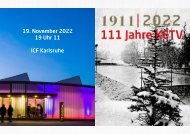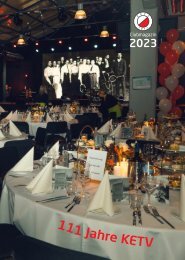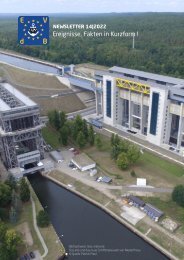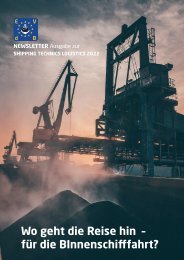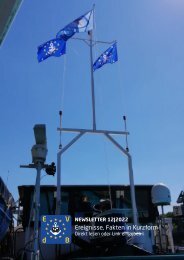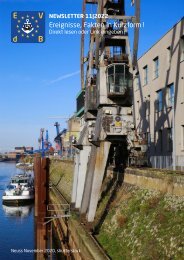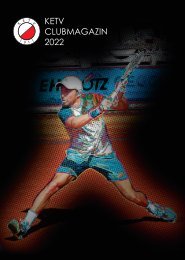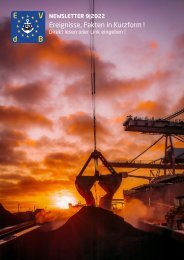You also want an ePaper? Increase the reach of your titles
YUMPU automatically turns print PDFs into web optimized ePapers that Google loves.
<strong>IWT</strong> <strong>Funding</strong> – Best <strong>practices</strong> and<br />
what we learned<br />
CCNR ECO committee<br />
5 OCTOBER 2022
01. 02.<br />
Introduction<br />
1. The need for financial<br />
incentives<br />
National experience<br />
Feedback on regional<br />
level<br />
03. 04.<br />
EU experience<br />
1. Feedback from<br />
recent proposals<br />
Conclusions<br />
What’s in for the CCNR<br />
ECO Committee
01. Introduction<br />
The need for financial incentives
The need for financial support in <strong>IWT</strong><br />
à There is no business case for ‘green’ vessels (newly built or retrofit)*<br />
à It’s a positive stimulation towards innovation & it works<br />
à There is no (EU) regulation trigger besides the EU Directive NRMM<br />
2016/1628 which incentiveses the <strong>IWT</strong> sector towards ‘greening’<br />
à All alternatives to fossil fuel techniques are more expensive<br />
à Customers/shippers are not actively demanding a ‘greener’<br />
transportation mode<br />
à Customers/shippers are in general not actively providing a higher<br />
transportation price - most economic solution is the <strong>best</strong> solution<br />
The need is clear, thus the access needs to be as easy as possible.<br />
*CCNR study on energy transition towards a zero-emission inland navigation sector
02. National<br />
experience<br />
Feedback on regional level
Financial schemes that were mentioned<br />
B - ‘Prime à l’acquisition d’un bateau de navigation intérieure d’occasion’<br />
B - Steunmaatregelen (De Vlaamse Waterweg nv)<br />
DE - BMDV: „Förderprogramm zur nachhaltigen Modernisierung von<br />
Binnenschiffen“<br />
DE - BMDV: „Förderprogramm zur Umrüstung von Gütermotorschiffen mit<br />
emissionsärmeren Dieselmotoren“<br />
DE - KfW: „KfW-Umweltprogramm – Kredit 240/241“<br />
NL - DKTI<br />
NL - RDM regeling Subsidieregeling R&D Mobiliteitssectoren (RDM)<br />
NL - Tijdelijke subsidieregeling verduurzaming binnenvaart<br />
NL - Nationaal Groeifonds
What did we learn - SCOPE<br />
Most financial schemes focus on specific techniques, which narrow the<br />
scope and create the illusion of excluding options/innovation/the market.<br />
Recommandations:<br />
Broaden the technical scope<br />
à e.g. aiming at a certain goal to be achieved instead of a technique to answer to<br />
à focus on modular innovative techniques, creating a ‘no regret decision’ for vessel<br />
owners – e.g. electromotor with modular/adaptable energy source – e.g. state of the<br />
art techniques such as STAGE V<br />
à clear approach for retrofitting and another one for newly built vessels<br />
Broad innovative scope means technical neutrality for the vessel owner, supporting<br />
technical manufacturers, such as digital innovation, noise reducing measurements,<br />
<strong>IWT</strong> automation, logistic efficiency measurements, etc.<br />
Being as inclusive as possible
What did we learn – CAPEX v.s. OPEX (AND INFRA)<br />
Financial support is usually given (%) on the additional CAPEX costs.<br />
Additional OPEX costs are most of the time excluded and so is financial<br />
support for possibly needed infrastructure.<br />
Recommandations:<br />
à As long as alternative energy sources are more expensive compared to<br />
fossil fuels, the stimulation of OPEX costs are needed in every way possible<br />
(financial support/regulation/…)<br />
à To include infrastructural stimulation, forming a consortium could be an<br />
additional requirement for extra means (but not a limitation!)<br />
Making alternative fuels attractive
What did we learn – BUSINESS SIZE<br />
The <strong>IWT</strong> sector is known for it’s SME structure. This goes from small business<br />
owners with 1 vessel to businesses with 50+ vessels. A trend can be seen that<br />
financial institutions are leaning towards favoring coöperative approaches to<br />
reduce the risk (even temporary coöperations).<br />
Recommandations:<br />
à To reduce the risk for all parties and maximize the goal towards<br />
innovation, additional requirements could be made to stimulate the creation<br />
of a consortium with different parties (but not a limition!)<br />
à Small vs large businesses need a different approach (risks are different)
- What did we learn - REQUIREMENTS<br />
Financial schemes can focus on the location of the business and not<br />
the region where the vessel(s) are active (or both). E.g. a company needs<br />
to be based x amount of years in a certain country/region to be eligible<br />
although the sailing region is adequate.<br />
Recommandations:<br />
<strong>IWT</strong> is a cross-border transportsector, which needs to be taken into<br />
account when providing financial incentives.<br />
à Focus on the activity of the vessel in the country/countries and not on<br />
the flag of the vessel (e.g. claim sailing hours)<br />
à Don’t exclude newly built vessels (no historical sailing hours yet) but<br />
work with a to be proven clausule/transport contract/…<br />
All shipowners face the same bottle necks and challenges.<br />
Being as inclusive as possible
What did we learn - TIMING<br />
Financial schemes are usually open for a certain amount of time, between 1<br />
and 3 years. No negative feedback, though innovation and regulation is<br />
changing quickly. Flexibility for change within the timeframe could be<br />
beneficial for all parties.<br />
Recommandations:<br />
à Fixed timing with regular renewal (e.g. annual, bi-annual, …) and<br />
discussion with national representatives for check up (PDCA – Plan, Do,<br />
Check, Act)<br />
à Timing based on calls (e.g. open call for 3 months) for specific purpose or<br />
topics which need a trial/extra motivation/…
What did we learn – TRL v.s. AMOUNT OF SUPPORT<br />
High TRL usually comes with lower financial support; although vessel owners<br />
are looking for solutions which are usually between TRL 7-9. The ‘no regret<br />
investment’ in a market where technical clarity is difficult to create. The<br />
innovation cycle is still at full pace and will be the upcoming decade.<br />
Low TRL comes with higher financial support – hesitation since the high risk<br />
of not being future proof and additional technical issues because of the low<br />
TRL.<br />
Recommandations:<br />
à The amount of financial support (%) can be differentiated with the TRL of a<br />
technique. Keep/make the support high enough for high TRL techniques to<br />
close the gap and allow the creation of a business case.<br />
Minimum of 50% financial support is proven to work
03. EU experience<br />
Feedback from recent proposals
EU <strong>Funding</strong> Programs - TRL<br />
In regards of grants for innovation and research activities, it is stated in the<br />
last Horizon 2020 work programme (2018-2020) that funded projects<br />
should cover a wide range of activities across the innovation cycle,<br />
including different TRL levels.<br />
However, it was mentioned that “grants shall not be awarded for actions<br />
where activities go above TRL 8”.<br />
The same threshold is also applied within the Horizon Europe regulation.*<br />
à Need for national funding support for TRL 7-9 to be complimentary<br />
with EU funding support<br />
*European Commission COM(2018) 435 final https://eur-lex.europa.eu/legalcontent/EN/TXT/?uri=CELEX%3A52018PC0435
TRL Levels - Defenition<br />
Within the European Union and its preceding support programme for<br />
research and innovation activities, Horizon 2020, TRL was defined within the<br />
“HORIZON 2020 –WORK PROGRAMME 2014-2015” Annex G “Technology<br />
readiness levels (TRL)” as following:<br />
TRL 1: basic principles observed;<br />
TRL 2: technology concept formulated;<br />
TRL 3: experimental proof of concept;<br />
TRL4: technology validated in lab;<br />
TRL 5: technology validated in relevant environment (industrially relevant<br />
environment in the case of key enabling technologies);<br />
TRL 6: technology demonstrated in relevant environment (industrially<br />
relevant environment in the case of key enabling technologies);<br />
TRL 7: system prototype demonstration in operational environment;<br />
TRL 8: system complete and qualified;<br />
TRL 9: actual system proven in operational environment (competitive<br />
manufacturing in the case of key enabling technologies; or in space)<br />
European Commission, HORIZON 2020 –WORK PROGRAMME 2014-2015” - Annex G:<br />
https://ec.europa.eu/research/participants/data/ref/h2020/wp/2014_2015/annexes/h2020-wp1415-annex-g-trl_en.pdf
EU <strong>Funding</strong> Programs – ADMIN. BURDEN<br />
- Only for large companies, who have the human capital/time/resources<br />
- Need for a specialized company to support the proposal writing<br />
- Not for the small business owners<br />
- Need for consortium<br />
- Risk of not being selected<br />
- Financial benefits are very low/too low<br />
à Need for national funding support to be as easy as possible since EU<br />
funding needs specialized companies<br />
*European Commission COM(2018) 435 final https://eur-lex.europa.eu/legalcontent/EN/TXT/?uri=CELEX%3A52018PC0435
EU <strong>Funding</strong> Programs – <strong>IWT</strong> EXPERIENCE<br />
Many declined proposals which were shared confidentially show in the<br />
feedback that ‘the reader’ of the proposal wasn’t familiar (enough) with <strong>IWT</strong><br />
as a transport mode.<br />
The success rate of <strong>IWT</strong> proposals is very low.<br />
- Text not strong enough<br />
- Innovative impact not high enough<br />
- TRL not low enough<br />
- Financial support not high enough to cover the costs/risk<br />
- …<br />
Even though specialized companies are helping these entrepreneurs.<br />
Recommendations:<br />
à Making EU Commission more familiar with the challenges <strong>IWT</strong> is<br />
facing and possible solutions for it – Call for flagship projects<br />
à Strengthen relationships with specialized subsidy companies
04. Conclusions<br />
What’s in for the CCNR committee
First: <strong>Funding</strong> actually works…<br />
…when all the puzzle pieces are aligned<br />
The fact that things change immediately when a marketable,<br />
reliable system is available and the funding is attractive can be<br />
seen in the many passenger vessels that have installed<br />
completely electric propulsion systems as a result of the funding.<br />
Another example is CLINSH and the 20+ vessels which installed<br />
the market ready after treatment systems (80-90% reduction for<br />
air quality emissions!)<br />
The Dutch scheme ‘SVB’ for renewing an old engine by state of<br />
the art STAGE V is asking for extra sources.<br />
Etc.
Bottle neck: Legal limitations<br />
De-minimis regulation with the consequence that the maximum amount<br />
per company is €100,000, and € 200,000 for small enterprises.<br />
(Hydrogen already + € 1 milj. CAPEX meaning 20% financial support is not<br />
enough)<br />
Example of the GBER applications is the Dutch Ministry of Transport who<br />
obviously assessed the legal situation differenty and bases the funding on<br />
Art. 36 (1) of the GBER. Nevertheless, the support is limited to 200,000 € per<br />
ship, perhaps in order to have a safeguard through the de-minimis<br />
regulation, at least for the small companies.<br />
With the new Environmental Guidelines, it will no longer be possible to<br />
fund NRMM-compliant engines at all, even though that would be the most<br />
achievable measure for cargo shipping at the moment.<br />
The German financial scheme can co-finance up to 80%, can we learn from<br />
this?<br />
à Can we create another financial ceiling?
Bottle neck: Fiscality<br />
Examples of credit funding, which presupposes that a bank is available to<br />
provide the financing. Limitation here, it depends on the cost of the measure<br />
and the company’s capital resources.<br />
<strong>Funding</strong> can be seen as income in some regions, causing the funding to be<br />
taxable. This is also a well-known problem.<br />
à Can an overview of the fiscal impact be made per country and avoid<br />
non-aligning measures?
General<br />
There is a clear need for (national) funding!<br />
àThere is no single access point/person to approach for an overview of national<br />
funding possibilities (e.g. EIBIP non active)<br />
àThere is no international public list of success stories of national funding to learn<br />
from and get inspiration<br />
àNeed for national funding support to be as easy as possible (administrative) since<br />
EU funding needs specialized companies<br />
àNeed for national funding support for TRL 8-9 to be complimentary with EU<br />
funding support<br />
àCan we stimulate another financial ceiling? Can we learn from other countries?<br />
àCan an overview of the fiscal impact be made per country and avoid non-aligning<br />
measures?<br />
àMaking EU Commission more familiar with the challenges <strong>IWT</strong> is facing and<br />
possible solutions for it – call for flagship projects
Thanks!<br />
Daisy Rycquart<br />
daisy@citbo.com



